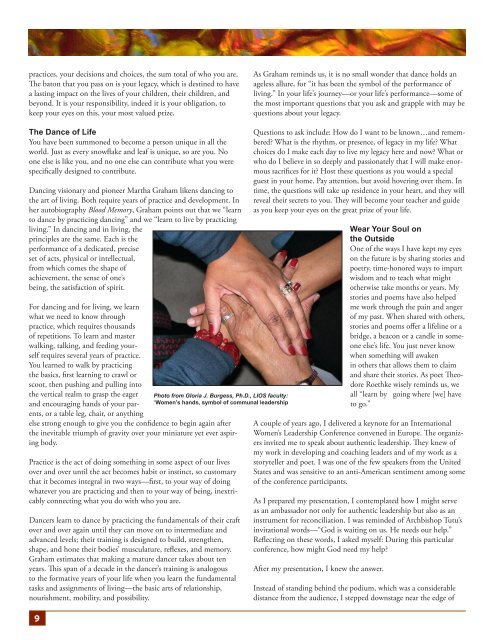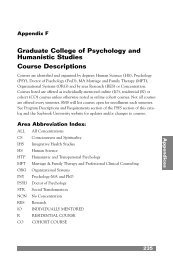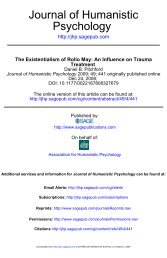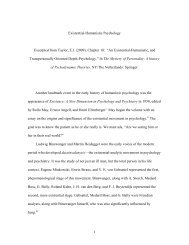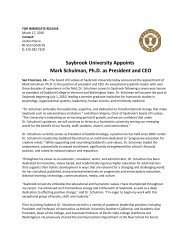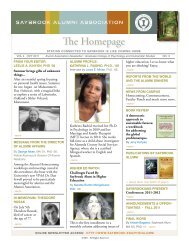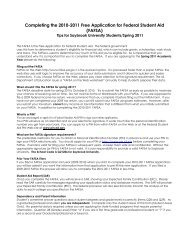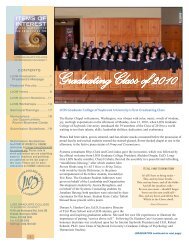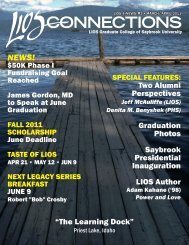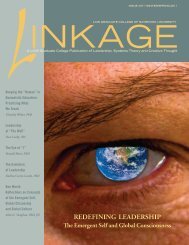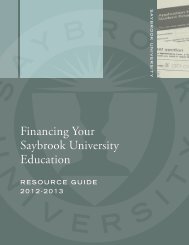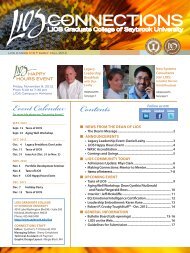A journal of creative thought and feeling published by LIOS ...
A journal of creative thought and feeling published by LIOS ...
A journal of creative thought and feeling published by LIOS ...
Create successful ePaper yourself
Turn your PDF publications into a flip-book with our unique Google optimized e-Paper software.
practices, your decisions <strong>and</strong> choices, the sum total <strong>of</strong> who you are.<br />
The baton that you pass on is your legacy, which is destined to have<br />
a lasting impact on the lives <strong>of</strong> your children, their children, <strong>and</strong><br />
beyond. It is your responsibility, indeed it is your obligation, to<br />
keep your eyes on this, your most valued prize.<br />
As Graham reminds us, it is no small wonder that dance holds an<br />
ageless allure, for “it has been the symbol <strong>of</strong> the performance <strong>of</strong><br />
living.” In your life’s journey—or your life’s performance—some <strong>of</strong><br />
the most important questions that you ask <strong>and</strong> grapple with may be<br />
questions about your legacy.<br />
The Dance <strong>of</strong> Life<br />
You have been summoned to become a person unique in all the<br />
world. Just as every snowflake <strong>and</strong> leaf is unique, so are you. No<br />
one else is like you, <strong>and</strong> no one else can contribute what you were<br />
specifically designed to contribute.<br />
Dancing visionary <strong>and</strong> pioneer Martha Graham likens dancing to<br />
the art <strong>of</strong> living. Both require years <strong>of</strong> practice <strong>and</strong> development. In<br />
her autobiography Blood Memory, Graham points out that we “learn<br />
to dance <strong>by</strong> practicing dancing” <strong>and</strong> we “learn to live <strong>by</strong> practicing<br />
living.” In dancing <strong>and</strong> in living, the<br />
principles are the same. Each is the<br />
performance <strong>of</strong> a dedicated, precise<br />
set <strong>of</strong> acts, physical or intellectual,<br />
from which comes the shape <strong>of</strong><br />
achievement, the sense <strong>of</strong> one’s<br />
being, the satisfaction <strong>of</strong> spirit.<br />
For dancing <strong>and</strong> for living, we learn<br />
what we need to know through<br />
practice, which requires thous<strong>and</strong>s<br />
<strong>of</strong> repetitions. To learn <strong>and</strong> master<br />
walking, talking, <strong>and</strong> feeding yourself<br />
requires several years <strong>of</strong> practice.<br />
You learned to walk <strong>by</strong> practicing<br />
the basics, first learning to crawl or<br />
scoot, then pushing <strong>and</strong> pulling into<br />
the vertical realm to grasp the eager<br />
<strong>and</strong> encouraging h<strong>and</strong>s <strong>of</strong> your parents,<br />
or a table leg, chair, or anything<br />
else strong enough to give you the confidence to begin again after<br />
the inevitable triumph <strong>of</strong> gravity over your miniature yet ever aspiring<br />
body.<br />
Practice is the act <strong>of</strong> doing something in some aspect <strong>of</strong> our lives<br />
over <strong>and</strong> over until the act becomes habit or instinct, so customary<br />
that it becomes integral in two ways—first, to your way <strong>of</strong> doing<br />
whatever you are practicing <strong>and</strong> then to your way <strong>of</strong> being, inextricably<br />
connecting what you do with who you are.<br />
Dancers learn to dance <strong>by</strong> practicing the fundamentals <strong>of</strong> their craft<br />
over <strong>and</strong> over again until they can move on to intermediate <strong>and</strong><br />
advanced levels; their training is designed to build, strengthen,<br />
shape, <strong>and</strong> hone their bodies’ musculature, reflexes, <strong>and</strong> memory.<br />
Graham estimates that making a mature dancer takes about ten<br />
years. This span <strong>of</strong> a decade in the dancer’s training is analogous<br />
to the formative years <strong>of</strong> your life when you learn the fundamental<br />
tasks <strong>and</strong> assignments <strong>of</strong> living—the basic arts <strong>of</strong> relationship,<br />
nourishment, mobility, <strong>and</strong> possibility.<br />
9<br />
Photo from Gloria J. Burgess, Ph.D., <strong>LIOS</strong> faculty:<br />
“Women’s h<strong>and</strong>s, symbol <strong>of</strong> communal leadership<br />
Questions to ask include: How do I want to be known…<strong>and</strong> remembered?<br />
What is the rhythm, or presence, <strong>of</strong> legacy in my life? What<br />
choices do I make each day to live my legacy here <strong>and</strong> now? What or<br />
who do I believe in so deeply <strong>and</strong> passionately that I will make enormous<br />
sacrifices for it? Host these questions as you would a special<br />
guest in your home. Pay attention, but avoid hovering over them. In<br />
time, the questions will take up residence in your heart, <strong>and</strong> they will<br />
reveal their secrets to you. They will become your teacher <strong>and</strong> guide<br />
as you keep your eyes on the great prize <strong>of</strong> your life.<br />
Wear Your Soul on<br />
the Outside<br />
One <strong>of</strong> the ways I have kept my eyes<br />
on the future is <strong>by</strong> sharing stories <strong>and</strong><br />
poetry, time-honored ways to impart<br />
wisdom <strong>and</strong> to teach what might<br />
otherwise take months or years. My<br />
stories <strong>and</strong> poems have also helped<br />
me work through the pain <strong>and</strong> anger<br />
<strong>of</strong> my past. When shared with others,<br />
stories <strong>and</strong> poems <strong>of</strong>fer a lifeline or a<br />
bridge, a beacon or a c<strong>and</strong>le in someone<br />
else’s life. You just never know<br />
when something will awaken<br />
in others that allows them to claim<br />
<strong>and</strong> share their stories. As poet Theodore<br />
Roethke wisely reminds us, we<br />
all “learn <strong>by</strong> going where [we] have<br />
to go.”<br />
A couple <strong>of</strong> years ago, I delivered a keynote for an International<br />
Women’s Leadership Conference convened in Europe. The organizers<br />
invited me to speak about authentic leadership. They knew <strong>of</strong><br />
my work in developing <strong>and</strong> coaching leaders <strong>and</strong> <strong>of</strong> my work as a<br />
storyteller <strong>and</strong> poet. I was one <strong>of</strong> the few speakers from the United<br />
States <strong>and</strong> was sensitive to an anti-American sentiment among some<br />
<strong>of</strong> the conference participants.<br />
As I prepared my presentation, I contemplated how I might serve<br />
as an ambassador not only for authentic leadership but also as an<br />
instrument for reconciliation. I was reminded <strong>of</strong> Archbishop Tutu’s<br />
invitational words—“God is waiting on us. He needs our help.”<br />
Reflecting on these words, I asked myself: During this particular<br />
conference, how might God need my help?<br />
After my presentation, I knew the answer.<br />
Instead <strong>of</strong> st<strong>and</strong>ing behind the podium, which was a considerable<br />
distance from the audience, I stepped downstage near the edge <strong>of</strong>


